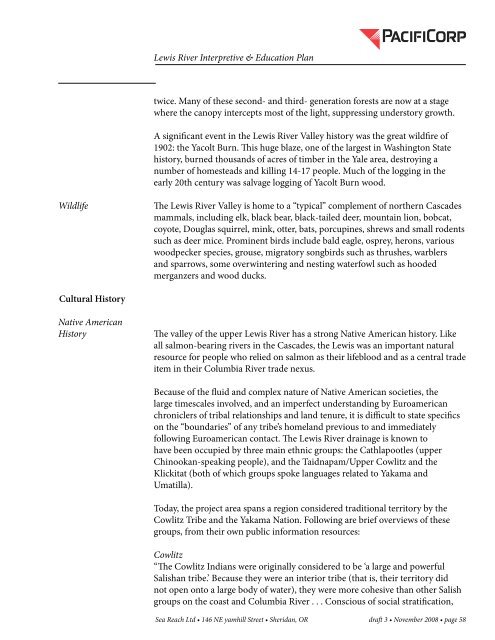The Lewis River Hydroelectric Projects - PacifiCorp
The Lewis River Hydroelectric Projects - PacifiCorp
The Lewis River Hydroelectric Projects - PacifiCorp
You also want an ePaper? Increase the reach of your titles
YUMPU automatically turns print PDFs into web optimized ePapers that Google loves.
<strong>Lewis</strong> <strong>River</strong> Interpretive & Education Plan<br />
twice. Many of these second- and third- generation forests are now at a stage<br />
where the canopy intercepts most of the light, suppressing understory growth.<br />
A significant event in the <strong>Lewis</strong> <strong>River</strong> Valley history was the great wildfire of<br />
1902: the Yacolt Burn. This huge blaze, one of the largest in Washington State<br />
history, burned thousands of acres of timber in the Yale area, destroying a<br />
number of homesteads and killing 14-17 people. Much of the logging in the<br />
early 20th century was salvage logging of Yacolt Burn wood.<br />
Wildlife<br />
<strong>The</strong> <strong>Lewis</strong> <strong>River</strong> Valley is home to a “typical” complement of northern Cascades<br />
mammals, including elk, black bear, black-tailed deer, mountain lion, bobcat,<br />
coyote, Douglas squirrel, mink, otter, bats, porcupines, shrews and small rodents<br />
such as deer mice. Prominent birds include bald eagle, osprey, herons, various<br />
woodpecker species, grouse, migratory songbirds such as thrushes, warblers<br />
and sparrows, some overwintering and nesting waterfowl such as hooded<br />
merganzers and wood ducks.<br />
Cultural History<br />
Native American<br />
History<br />
<strong>The</strong> valley of the upper <strong>Lewis</strong> <strong>River</strong> has a strong Native American history. Like<br />
all salmon-bearing rivers in the Cascades, the <strong>Lewis</strong> was an important natural<br />
resource for people who relied on salmon as their lifeblood and as a central trade<br />
item in their Columbia <strong>River</strong> trade nexus.<br />
Because of the fluid and complex nature of Native American societies, the<br />
large timescales involved, and an imperfect understanding by Euroamerican<br />
chroniclers of tribal relationships and land tenure, it is difficult to state specifics<br />
on the “boundaries” of any tribe’s homeland previous to and immediately<br />
following Euroamerican contact. <strong>The</strong> <strong>Lewis</strong> <strong>River</strong> drainage is known to<br />
have been occupied by three main ethnic groups: the Cathlapootles (upper<br />
Chinookan-speaking people), and the Taidnapam/Upper Cowlitz and the<br />
Klickitat (both of which groups spoke languages related to Yakama and<br />
Umatilla).<br />
Today, the project area spans a region considered traditional territory by the<br />
Cowlitz Tribe and the Yakama Nation. Following are brief overviews of these<br />
groups, from their own public information resources:<br />
Cowlitz<br />
“<strong>The</strong> Cowlitz Indians were originally considered to be ‘a large and powerful<br />
Salishan tribe.’ Because they were an interior tribe (that is, their territory did<br />
not open onto a large body of water), they were more cohesive than other Salish<br />
groups on the coast and Columbia <strong>River</strong> . . . Conscious of social stratification,<br />
Sea Reach Ltd • 146 NE yamhill Street • Sheridan, OR draft 3 • November 2008 • page 58
















